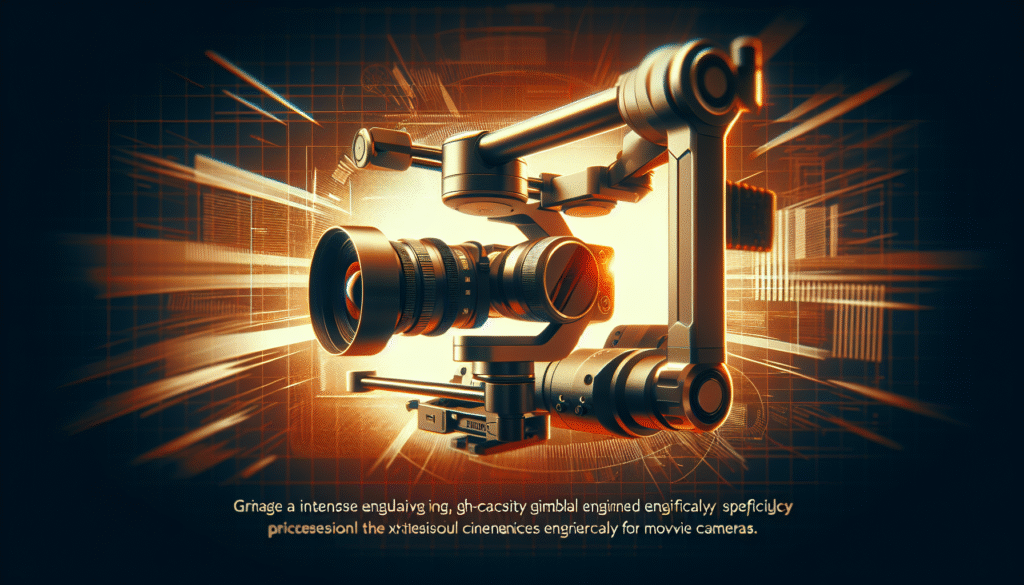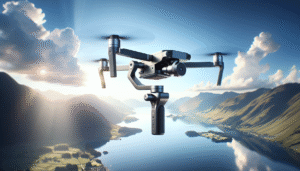Isn’t it fascinating how a simple question can open up an entire world of exploration? Have you ever found yourself curious about the tools used to capture the magic of cinema, specifically those powerhouse devices that can shoulder the professional gear necessary for filming? I’m talking about heavy-lift gimbals for cinema cameras, with the impressive ability to support payloads of 5kg or more. These aren’t your run-of-the-mill gimbals; these are the unsung heroes behind the breathtaking, smooth, cinematic shots that captivate audiences worldwide.

Understanding the Need for Heavy-Lift Gimbals
Before I get into the nitty-gritty of the best heavy-lift gimbals, let me first paint a picture of why they’re so vital in the filmmaking world. Imagine trying to run a marathon while balancing a plate of your favorite pie. You need something to stabilize that pie—because, yes, a delicious pie should never be wasted—and this is where heavy-lift gimbals come into play for cameras. They’re the professional-grade tools designed to stabilize hefty cinema cameras, ensuring filmmakers can capture silky-smooth shots even under the most dynamic conditions.
Why a 5kg+ Payload?
If you’re wondering why a camera setup might weigh over 5kg, let me break it down for you. Professional cinema cameras are beasts. They are often equipped with large lenses, follow focus systems, matte boxes, and external monitors, among other accessories. All this adds up to a heavy load which requires a robust gimbal to manage the weight and maintain stability during filming. Without a reliable gimbal, even the best cameras could deliver shaky footage, which is usually not the desired result unless you’re shooting a found-footage horror film.
Top Heavy-Lift Gimbals for Cinema Cameras
With a burgeoning interest in capturing high-quality cinema, the market offers several excellent heavy-lift gimbals. Here’s where I step in to guide you through some of the best available options, detailing their standout features and anything else that makes them worth considering.
1. DJI Ronin 2
Let’s start with a name that’s synonymous with quality in the drone world and has made an impressive mark in the gimbal market.
Features:
- Maximum Payload: 13.6 kg
- Battery Life: Up to 8 hours
- Weight: 4.2 kg (without any accessories)
- Stabilization: Pan, tilt, and roll
The Ronin 2 excels with its motors that can withstand high wind speeds and G-forces, making it suitable even for vehicle mounting. What’s most endearing about this gimbal is its user-friendly interface, allowing for quick balancing and adjustment. Perfect for those of us who thrive on efficiency and maybe a little short on patience. Its hot-swappable batteries ensure uninterrupted shooting, which is quite the lifesaver during extended filming sessions.
2. Freefly Systems MoVI Pro
Next, I find myself drawn to the Freefly Systems MoVI Pro, which offers an enticing blend of sophistication and simplicity.
Features:
- Maximum Payload: 6.8 kg
- Battery Life: Approximately 1.5 hours
- Weight: 2.7 kg
- Stabilization: 3-axis stabilization system
The MoVI Pro is famed for its versatility, enabling dual-operator control and boasting a smart ecosystem that integrates well with various camera accessories. It’s the gimbal equivalent of a Swiss Army Knife, designed to empower filmmakers to seize every opportunity for a creative shot. What strikes me is its ability to cater to both novices and experts in the industry, making it a very accommodating piece of equipment.
3. Zhiyun Crane 3S
Another strong contender in the heavy-lift gimbal arena is the Zhiyun Crane 3S, which distinguishes itself through power and extendibility.
Features:
- Maximum Payload: 6.5 kg
- Battery Life: 12 hours
- Weight: 3.7 kg
- Stabilization: Optimized 3-axis
The Crane 3S is adept at handling large setups due to its modern modular design, making it a favorite for filmmakers who need adaptability on set. Its Extendable Arm feature makes balancing easier when switching between different camera models. It’s like having a personal assistant that’s tireless and never complains about long hours.
4. Tilta Gravity G2X
And here we have the Tilta Gravity G2X, a gimbal that emphasizes precision and compact design.
Features:
- Maximum Payload: 5 kg
- Battery Life: 10 hours
- Weight: 2.6 kg
- Stabilization: Precision 3-axis system
The attractive aspect of the Gravity G2X is its ease of use straight out of the box. I love how you can simply attach your camera and start shooting due to its intuitive balancing system and quick release mechanisms. It’s particularly appealing for independent filmmakers or documentary crews who may often work solo.
5. Gudsen MOZA Air 2
Last but not least is the Gudsen MOZA Air 2, a gimbal that combines affordability with functionality.
Features:
- Maximum Payload: 4.2 kg
- Battery Life: 16 hours
- Weight: 1.6 kg
- Stabilization: Comprehensive 3-axis control
The Moza Air 2 is the definition of getting more bang for your buck. It integrates multi-can operations and a comprehensible interface that enables auto-tuning. It’s a reliable companion if you’re looking to capture breathtaking landscapes or intricate cityscapes, all while making sure your wallet remains as stable as your shots.

Choosing the Right Gimbal
Now, you might be juggling the options and wondering, “Which gimbal is right for me?” The answer hinges on a few considerations. Let’s break it down like sipping a cup of coffee on a quiet morning.
Budget Considerations
A good starting point is assessing the budget. The gimbals I’ve listed vary in price, reflecting their capabilities and the brand name’s weight. Don’t worry, though. There are solid options for a variety of price points. Be sure to match the gimbal to your filming needs and financial comfort level.
Shooting Environment
Consider your shooting environment. Will you be capturing scenes in bustling cityscapes, serene nature reserves, or perhaps from a fast-moving vehicle? This will help determine which gimbal—like the Ronin 2 or Crane 3S for high-speed scenarios—best suits your needs based on their innovative features.
Payload Capacity
Evaluate your typical camera setup to ensure the gimbal can comfortably handle the load. Remember, overloading a gimbal can cause mechanical issues or impact performance, so always account for every accessory attached to your camera.
Maintenance and Care Tips for Heavy-Lift Gimbals
Owning a high-performance gimbal is akin to adopting a pet. It demands love, care, and an understanding of its whims and peculiarities. Here’s where a maintenance routine becomes beneficial.
Routine Cleaning
Always keep dust, dirt, and moisture at bay. A light microfiber cloth can work wonders for surface cleaning. Avoid abrasive chemicals and never submerge any part of your gimbal in water. Simple, right?
Regular Calibration
Regularly calibrate your gimbal to keep it in optimal working condition, especially after moving to a new location or adjusting your camera setup. This ensures that stabilization remains top-notch.
Battery Management
Properly manage your gimbal’s battery cycles. Overcharging can reduce battery life, while inadequate charging might leave you in a lurch on an important shoot day. It’s all about balance—much like life itself.
The Evolution of Gimbals in Cinema
Technology often feels like a hyperactive child, always evolving rapidly and revealing new wonders daily. Gimbals have not been immune to this whirlwind. From the inception of rudimentary stabilization to today’s state-of-the-art, sensor-packed marvels, gimbals have transformed the filming landscape drastically.
Early Influence
Initially, stabilizing mechanisms were primitive, often reliant on cumbersome and intricate mechanical systems. Enter the gimbal—a revolution that changed how motion could be tracked and filmed seamlessly, liberating filmmakers from static shots.
Modern Marvels
Modern gimbals, like the ones discussed, are engineering marvels; full of electronic wizardry and intuitive controls. They’re designed to respond to human input with incredible precision, being almost an extension of the filmmaker’s natural reflexes.
The Future of Heavy-Lift Gimbals
I can’t help but be intrigued by what the future holds for these technological marvels. I imagine gimbals continuing to grow smarter, lighter, and more versatile, perhaps integrating machine learning to anticipate a filmmaker’s next move. Opportunities in augmented reality or even haptic feedback to give real-time tactile control could become part of the standard suite.
Sustainability Practices
As with all technology, there’s an increasing push for eco-friendly practices. The future might see the integration of sustainable materials and energy-efficient designs in gimbal production—an evolution making not just waves in cinema, but in the global conversation on sustainability.
AI Integration
Artificial intelligence could play a larger role, automating complex movements or learning shooting habits to adjust settings on the fly, thereby further lowering the barrier for entry-level filmmakers and streamlining workflows for seasoned professionals.
Final Thoughts
Exploring the realm of heavy-lift gimbals for cinema cameras has been akin to embarking on an enlightening odyssey. These incredible devices have bridged the gap between what was once impossible and what is now routine, allowing filmmakers to realize their creative visions with poise and precision. As the cinematic world continues to evolve, so too will the tools that bring these visions to the silver screen. I encourage you to experiment and find the perfect match for your filmmaking journey. After all, every masterpiece begins with a single, steady frame.
![Best Gimbal For DJI Mini 4 Pro In 2025 [Top Picks + Quick Deals]](https://droneaperture.com/wp-content/uploads/2025/06/best-gimbal-for-dji-mini-4-pro-in-2025-top-picks-quick-deals-1-300x171.png)
![Top 5 Drone Gimbals For Cinematic Footage Under $500 [2025 Tested]](https://droneaperture.com/wp-content/uploads/2025/06/top-5-drone-gimbals-for-cinematic-footage-under-500-2025-tested-300x171.png)
